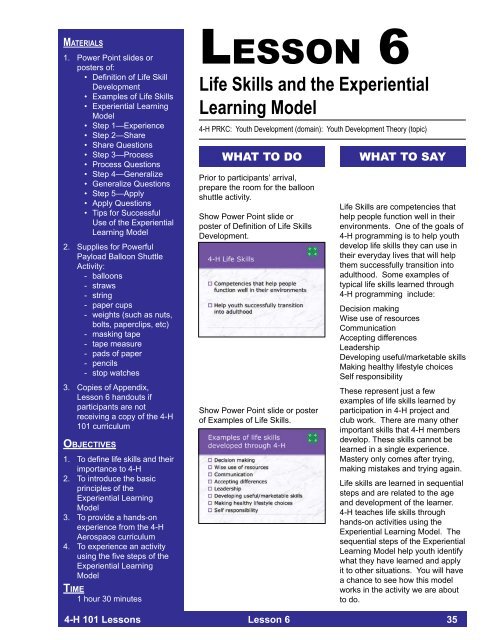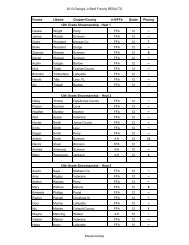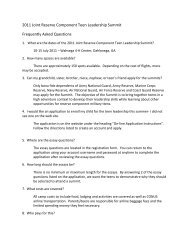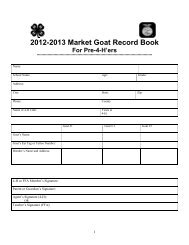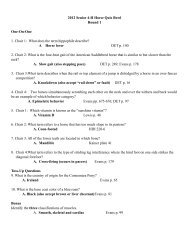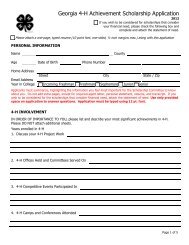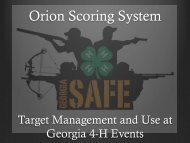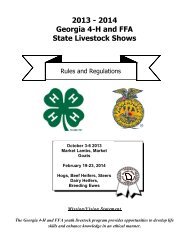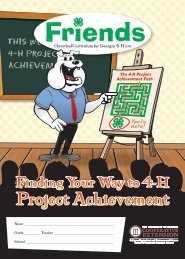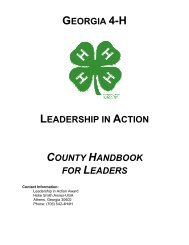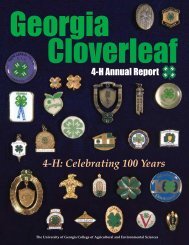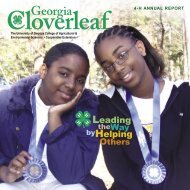Lesson 6 - Life Skills and the Experiential Learning ... - Georgia 4-H
Lesson 6 - Life Skills and the Experiential Learning ... - Georgia 4-H
Lesson 6 - Life Skills and the Experiential Learning ... - Georgia 4-H
You also want an ePaper? Increase the reach of your titles
YUMPU automatically turns print PDFs into web optimized ePapers that Google loves.
Mat e r i a l s<br />
1. Power Point slides or<br />
posters of:<br />
• Definition of <strong>Life</strong> Skill<br />
Development<br />
• Examples of <strong>Life</strong> <strong>Skills</strong><br />
• <strong>Experiential</strong> <strong>Learning</strong><br />
Model<br />
• Step 1—Experience<br />
• Step 2—Share<br />
• Share Questions<br />
• Step 3—Process<br />
• Process Questions<br />
• Step 4—Generalize<br />
• Generalize Questions<br />
• Step 5—Apply<br />
• Apply Questions<br />
• Tips for Successful<br />
Use of <strong>the</strong> <strong>Experiential</strong><br />
<strong>Learning</strong> Model<br />
2. Supplies for Powerful<br />
Payload Balloon Shuttle<br />
Activity:<br />
- balloons<br />
- straws<br />
- string<br />
- paper cups<br />
- weights (such as nuts,<br />
bolts, paperclips, etc)<br />
- masking tape<br />
- tape measure<br />
- pads of paper<br />
- pencils<br />
- stop watches<br />
3. Copies of Appendix,<br />
<strong>Lesson</strong> 6 h<strong>and</strong>outs if<br />
participants are not<br />
receiving a copy of <strong>the</strong> 4-H<br />
101 curriculum<br />
Ob j e c t i v e s<br />
1. To define life skills <strong>and</strong> <strong>the</strong>ir<br />
importance to 4-H<br />
2. To introduce <strong>the</strong> basic<br />
principles of <strong>the</strong><br />
<strong>Experiential</strong> <strong>Learning</strong><br />
Model<br />
3. To provide a h<strong>and</strong>s-on<br />
experience from <strong>the</strong> 4-H<br />
Aerospace curriculum<br />
4. To experience an activity<br />
using <strong>the</strong> five steps of <strong>the</strong><br />
<strong>Experiential</strong> <strong>Learning</strong><br />
Model<br />
Ti m e<br />
1 hour 30 minutes<br />
Le s s o n 6<br />
<strong>Life</strong> <strong>Skills</strong> <strong>and</strong> <strong>the</strong> <strong>Experiential</strong><br />
<strong>Learning</strong> Model<br />
4-H PRKC: Youth Development (domain): Youth Development Theory (topic)<br />
WHAT TO DO<br />
Prior to participants’ arrival,<br />
prepare <strong>the</strong> room for <strong>the</strong> balloon<br />
shuttle activity.<br />
Show Power Point slide or<br />
poster of Definition of <strong>Life</strong> <strong>Skills</strong><br />
Development.<br />
Show Power Point slide or poster<br />
of Examples of <strong>Life</strong> <strong>Skills</strong>.<br />
WHAT TO SAY<br />
<strong>Life</strong> <strong>Skills</strong> are competencies that<br />
help people function well in <strong>the</strong>ir<br />
environments. One of <strong>the</strong> goals of<br />
4-H programming is to help youth<br />
develop life skills <strong>the</strong>y can use in<br />
<strong>the</strong>ir everyday lives that will help<br />
<strong>the</strong>m successfully transition into<br />
adulthood. Some examples of<br />
typical life skills learned through<br />
4-H programming include:<br />
Decision making<br />
Wise use of resources<br />
Communication<br />
Accepting differences<br />
Leadership<br />
Developing useful/marketable skills<br />
Making healthy lifestyle choices<br />
Self responsibility<br />
These represent just a few<br />
examples of life skills learned by<br />
participation in 4-H project <strong>and</strong><br />
club work. There are many o<strong>the</strong>r<br />
important skills that 4-H members<br />
develop. These skills cannot be<br />
learned in a single experience.<br />
Mastery only comes after trying,<br />
making mistakes <strong>and</strong> trying again.<br />
<strong>Life</strong> skills are learned in sequential<br />
steps <strong>and</strong> are related to <strong>the</strong> age<br />
<strong>and</strong> development of <strong>the</strong> learner.<br />
4-H teaches life skills through<br />
h<strong>and</strong>s-on activities using <strong>the</strong><br />
<strong>Experiential</strong> <strong>Learning</strong> Model. The<br />
sequential steps of <strong>the</strong> <strong>Experiential</strong><br />
<strong>Learning</strong> Model help youth identify<br />
what <strong>the</strong>y have learned <strong>and</strong> apply<br />
it to o<strong>the</strong>r situations. You will have<br />
a chance to see how this model<br />
works in <strong>the</strong> activity we are about<br />
to do.<br />
4-H 101 <strong>Lesson</strong>s <strong>Lesson</strong> 6 35
WHAT TO DO<br />
WHAT TO SAY<br />
We will talk more about <strong>the</strong><br />
<strong>Experiential</strong> <strong>Learning</strong> Model after<br />
we have finished our activity. Now,<br />
let’s get started.<br />
Divide participants into groups of<br />
4-6 <strong>and</strong> place groups as far away<br />
from each o<strong>the</strong>r as possible. Each<br />
group should have one piece<br />
of string long enough to reach<br />
from <strong>the</strong> floor to <strong>the</strong> ceiling on a<br />
diagonal <strong>and</strong> three smaller pieces<br />
of string. Place one of each of<br />
<strong>the</strong> remaining items listed under<br />
supplies at each group station.<br />
(This activity also can be done<br />
with <strong>the</strong> string running horizontally<br />
across <strong>the</strong> room from wall to wall.)<br />
Give participants 10 minutes to<br />
complete <strong>the</strong> experiment.<br />
After everyone has launched <strong>the</strong>ir<br />
balloon, give <strong>the</strong>m a new set of<br />
instructions.<br />
Give participants about 5 minutes<br />
to add baskets <strong>and</strong> weights to <strong>the</strong>ir<br />
balloon shuttles.<br />
Today, you are going to create a<br />
balloon shuttle from <strong>the</strong> supplies<br />
we have provided at each station.<br />
We also have some stop watches<br />
that you can use to measure <strong>the</strong><br />
time it takes for your shuttle to<br />
reach its destination <strong>and</strong> a tape<br />
measure, pad of paper <strong>and</strong> pencil<br />
to record times <strong>and</strong> distances.<br />
Listen carefully to <strong>the</strong> directions:<br />
First, thread <strong>the</strong> string through <strong>the</strong><br />
drinking straw. Take your long<br />
piece of string <strong>and</strong> tape <strong>the</strong> ends<br />
to <strong>the</strong> ceiling <strong>and</strong> floor. (Or attach<br />
<strong>the</strong> string to a wall if ceilings are<br />
too high. The string should be long<br />
enough to reach to <strong>the</strong> opposite<br />
wall.)<br />
Designate someone as a timer <strong>and</strong><br />
recorder. Inflate <strong>the</strong> balloon, pinch<br />
it closed but do not tie it. Attach <strong>the</strong><br />
balloon to <strong>the</strong> straw with tape <strong>and</strong><br />
release <strong>the</strong> balloon. Record <strong>the</strong><br />
distance <strong>and</strong> speed.<br />
Now I want you to add a basket to<br />
your shuttle using <strong>the</strong> paper cup<br />
<strong>and</strong> three shorter pieces of string.<br />
Using tape, attach <strong>the</strong> basket to<br />
<strong>the</strong> balloon. Then, attach your<br />
balloon <strong>and</strong> basket to <strong>the</strong> straw<br />
again, release <strong>the</strong>m <strong>and</strong> record <strong>the</strong><br />
distance <strong>and</strong> speed.<br />
Next, I would like you to add<br />
weights (paper clips, nuts, bolts,<br />
etc.) to your basket <strong>and</strong> try <strong>the</strong><br />
experiment again. Don’t forget to<br />
record your results.<br />
Have participants return to <strong>the</strong>ir<br />
seats. Ask <strong>the</strong> following questions,<br />
allowing about 10-15 minutes for<br />
discussion.<br />
How did you feel when you were<br />
building your balloon shuttle?<br />
How did it feel when you were<br />
testing it?<br />
36 <strong>Lesson</strong> 6 4-H 101 <strong>Lesson</strong>s
WHAT TO DO<br />
WHAT TO SAY<br />
What did you think would happen<br />
when you launched your shuttle?<br />
What did you expect to happen<br />
when you put <strong>the</strong> baskets <strong>and</strong> <strong>the</strong><br />
weights on your shuttles?<br />
How did you make your shuttle?<br />
How did your group decide who<br />
would do what part of <strong>the</strong> task?<br />
What challenges did you have in<br />
making your shuttle?<br />
What effect did <strong>the</strong> size of your<br />
balloon have on <strong>the</strong> distance <strong>and</strong><br />
speed of your shuttle?<br />
What did you learn about building<br />
<strong>and</strong> launching a shuttle?<br />
What did you learn about involving<br />
everyone in your group in <strong>the</strong> task?<br />
How would you teach youth in<br />
your program to make a balloon<br />
shuttle?<br />
What would you do differently<br />
when you teach this?<br />
What did you learn from this<br />
experience that would help you<br />
teach o<strong>the</strong>r concepts to a group?<br />
Show <strong>the</strong> Power Point slide or<br />
poster of <strong>the</strong> <strong>Experiential</strong> <strong>Learning</strong><br />
Model.<br />
Here is a graphic of <strong>the</strong><br />
<strong>Experiential</strong> <strong>Learning</strong> Model used<br />
by 4-H. This model involves a<br />
five-part process that incorporates<br />
doing something, reflecting<br />
upon it <strong>and</strong> applying what was<br />
learned. We just experienced it<br />
ourselves with <strong>the</strong> balloon shuttle<br />
experiment.<br />
Let’s look at each of <strong>the</strong> steps in<br />
<strong>the</strong> process.<br />
4-H 101 <strong>Lesson</strong>s <strong>Lesson</strong> 6 37
WHAT TO DO<br />
Show <strong>the</strong> Power Point slide or<br />
poster of Definition of Step 1 –<br />
Experience.<br />
Show <strong>the</strong> Power Point slide or<br />
poster of Definition of Step 2 –<br />
Share.<br />
Show <strong>the</strong> Power Point slide or<br />
poster of <strong>the</strong> Share Questions.<br />
Show <strong>the</strong> Power Point slide or<br />
poster of Definition of Step 3 –<br />
Process.<br />
WHAT TO SAY<br />
As you can see, <strong>the</strong> model<br />
begins with a planned experience<br />
that is designed to provide an<br />
opportunity to learn a specific<br />
skill. It will probably be something<br />
new for <strong>the</strong> learner <strong>and</strong> should<br />
push individuals beyond previous<br />
experiences.<br />
In <strong>the</strong> activity we just did, we<br />
used <strong>the</strong> building <strong>and</strong> launching<br />
of a balloon shuttle to involve you<br />
in a h<strong>and</strong>s-on learning-by-doing<br />
activity.<br />
The sharing process begins with<br />
asking questions designed to<br />
get individuals to share reactions<br />
<strong>and</strong> observations <strong>and</strong> to discuss<br />
feelings generated by <strong>the</strong><br />
experience.<br />
We ask <strong>the</strong>se types of questions<br />
to help participants reflect on<br />
what <strong>the</strong>y have done. These are<br />
generally questions associated<br />
with senses (seeing, feeling,<br />
hearing, tasting, etc.) <strong>and</strong> levels of<br />
difficulty.<br />
In our discussion earlier, we asked<br />
<strong>the</strong> following share questions:<br />
How did you feel when you were<br />
building your balloon shuttle?<br />
How did it feel when you were<br />
testing it?<br />
What did you think would happen<br />
when you launched your shuttle?<br />
What did you expect to happen<br />
when you put <strong>the</strong> baskets <strong>and</strong> <strong>the</strong><br />
weights on your shuttles?<br />
The next step in <strong>the</strong> model is to<br />
identify <strong>the</strong> process or how <strong>the</strong><br />
experience was actually carried<br />
out. How were specific problems<br />
or issues addressed? In this step,<br />
you encourage <strong>the</strong> group to look<br />
for recurring <strong>the</strong>mes.<br />
38 <strong>Lesson</strong> 6 4-H 101 <strong>Lesson</strong>s
WHAT TO DO<br />
Show <strong>the</strong> Power Point slide or<br />
poster of <strong>the</strong> Process Questions.<br />
WHAT TO SAY<br />
Questions that encourage<br />
discussion about process usually<br />
involve how participants actually<br />
did <strong>the</strong> activity <strong>and</strong> if <strong>the</strong>re were<br />
any problems that arose. If so,<br />
how were <strong>the</strong>se problems dealt<br />
with?<br />
In our discussion earlier, <strong>the</strong><br />
process questions included:<br />
How did you make your shuttle?<br />
How did your group decide who<br />
would do what part of <strong>the</strong> task?<br />
What challenges did you have in<br />
making your shuttle?<br />
What effect did <strong>the</strong> size of your<br />
balloon have on <strong>the</strong> distance <strong>and</strong><br />
speed of your shuttle?<br />
Show <strong>the</strong> Power Point slide or<br />
poster of Definition of Step 4 –<br />
Generalize.<br />
Show <strong>the</strong> Power Point slide<br />
or poster of <strong>the</strong> Generalize<br />
Questions.<br />
Step four is when we can begin to<br />
generalize from <strong>the</strong> experience.<br />
This is when <strong>the</strong> learner begins to<br />
apply what was learned to what he/<br />
she already knew. This step helps<br />
participants determine how <strong>the</strong><br />
experience was important for <strong>the</strong>m.<br />
Listing key terms that capture <strong>the</strong><br />
learning can be a helpful exercise<br />
in this step.<br />
Questions that encourage<br />
discussion about generalizing<br />
include:<br />
What was learned from <strong>the</strong><br />
experience?<br />
How does this new information<br />
relate to o<strong>the</strong>r things participants<br />
have learned?<br />
In our discussion earlier, <strong>the</strong><br />
generalize questions I asked you<br />
were:<br />
What did you learn about building<br />
<strong>and</strong> launching a shuttle that could<br />
be applied to something else?<br />
What did you learn about involving<br />
everyone in your group in <strong>the</strong> task?<br />
4-H 101 <strong>Lesson</strong>s <strong>Lesson</strong> 6 39
WHAT TO DO<br />
Show <strong>the</strong> Power Point slide or<br />
poster of Definition of Step 5 –<br />
Apply.<br />
WHAT TO SAY<br />
In <strong>the</strong> last step, <strong>the</strong> <strong>Experiential</strong><br />
<strong>Learning</strong> Model addresses <strong>the</strong><br />
“now what” application of <strong>the</strong><br />
experience <strong>and</strong> explores how <strong>the</strong><br />
information learned can be applied<br />
to o<strong>the</strong>r situations.<br />
Questions to use that encourage<br />
application include:<br />
How can learners use what <strong>the</strong>y<br />
learned? How does what <strong>the</strong>y<br />
learned apply to o<strong>the</strong>r parts of <strong>the</strong>ir<br />
lives?<br />
Show <strong>the</strong> Power Point slide or<br />
poster of <strong>the</strong> Apply Questions.<br />
Apply questions that I asked you<br />
earlier in our discussion included:<br />
How would you teach youth to<br />
make a balloon shuttle?<br />
What would you do differently<br />
when you teach this?<br />
What did you learn from this<br />
experience that would help you<br />
teach o<strong>the</strong>r concepts to a group?<br />
Debriefing is what moves an<br />
activity to a learning experience.<br />
The primary purpose of processing<br />
<strong>the</strong> experience is to allow<br />
participants <strong>the</strong> opportunity to<br />
integrate <strong>the</strong>ir learning <strong>and</strong> come<br />
to closure with <strong>the</strong> activity.<br />
As we mentioned earlier, 4-H uses<br />
<strong>the</strong> <strong>Experiential</strong> <strong>Learning</strong> Model to<br />
teach life skills. Remember to plan<br />
activities that use this approach<br />
<strong>and</strong> start with targeted goals.<br />
These goals are <strong>the</strong> life skills that<br />
you wish to teach.<br />
Allow about 5 minutes for<br />
discussion. If not brought up<br />
in discussion, point out that<br />
this activity targets teamwork,<br />
observation, <strong>and</strong> problem-solving<br />
skills, among o<strong>the</strong>rs.<br />
What life skills is <strong>the</strong> balloon<br />
activity intended to develop?<br />
40 <strong>Lesson</strong> 6 4-H 101 <strong>Lesson</strong>s
WHAT TO DO<br />
WHAT TO SAY<br />
The <strong>Experiential</strong> <strong>Learning</strong> Model<br />
is an effective way to teach youth<br />
<strong>and</strong> process <strong>the</strong> learning that<br />
occurs. Let’s review some tips for<br />
using it successfully.<br />
• Plan activities that relate to <strong>the</strong><br />
learning goals.<br />
• Plan for time to reflect on <strong>the</strong><br />
experience.<br />
Show Power Point slide or poster<br />
of Tips for Successful Use of <strong>the</strong><br />
<strong>Experiential</strong> <strong>Learning</strong> Model.<br />
• Ask <strong>the</strong> right questions. These<br />
must be prepared ahead of<br />
time as you are thinking<br />
through <strong>the</strong> learning activity.<br />
Sometimes a short activity<br />
where everyone answers a<br />
question like “I learned that….”<br />
will stimulate discussion.<br />
• Listen carefully to <strong>the</strong> youth.<br />
• Support each young person’s<br />
unique learning style.<br />
• Be aware of <strong>the</strong> step of <strong>the</strong><br />
<strong>Experiential</strong> <strong>Learning</strong> Model<br />
in which <strong>the</strong> group is working<br />
<strong>and</strong> be prepared to help move<br />
<strong>the</strong> group to <strong>the</strong> next step<br />
when <strong>the</strong>y are ready.<br />
Remember to adjust your<br />
questions based on <strong>the</strong>ir<br />
responses.<br />
The questions discussed in<br />
<strong>the</strong> processing <strong>and</strong> application<br />
steps will often provide excellent<br />
feedback. Even better evaluation<br />
information can be ga<strong>the</strong>red when<br />
you observe <strong>the</strong> group applying<br />
what <strong>the</strong>y learned to ano<strong>the</strong>r<br />
situation.<br />
Re f e r e n c e s<br />
Kolb, D. 1984. <strong>Experiential</strong><br />
<strong>Learning</strong>: Experience as<br />
<strong>the</strong> Source of <strong>Learning</strong> <strong>and</strong><br />
Development, Prentice Hall,<br />
Englewood Cliffs, NJ.<br />
In <strong>the</strong> next lesson we are going to<br />
explore curricula that are based<br />
on <strong>the</strong> experiential learning model<br />
<strong>and</strong> that support a wide variety of<br />
learning styles.<br />
4-H 101 <strong>Lesson</strong>s <strong>Lesson</strong> 6 41


